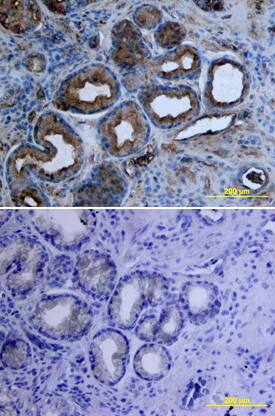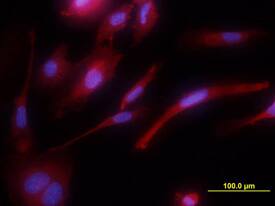Human Tie-1 Antibody
R&D Systems, part of Bio-Techne | Catalog # MAB619

Key Product Details
Species Reactivity
Validated:
Cited:
Applications
Validated:
Cited:
Label
Antibody Source
Product Specifications
Immunogen
Ala22-Gln760 (predicted)
Accession # P35590
Specificity
Clonality
Host
Isotype
Scientific Data Images for Human Tie-1 Antibody
Tie‑1 in HUVEC Human Cells.
Tie-1 was detected in immersion fixed HUVEC human umbilical vein endothelial cells using Mouse Anti-Human Tie-1 Monoclonal Antibody (Catalog # MAB619) at 10 µg/mL for 3 hours at room temperature. Cells were stained using the NorthernLights™ 557-conjugated Anti-Mouse IgG Secondary Antibody (red; Catalog # NL007) and counterstained with DAPI (blue). View our protocol for Fluorescent ICC Staining of Cells on Coverslips.Tie-1 in Human Gastric Cancer Tissue.
Tie-1 was detected in immersion fixed paraffin-embedded sections of human gastric cancer tissue using Mouse Anti-Human Tie-1 Monoclonal Antibody (Catalog # MAB619) at 25 µg/mL overnight at 4 °C. Tissue was stained using the Anti-Mouse HRP-DAB Cell & Tissue Staining Kit (brown; Catalog # CTS002) and counterstained with hematoxylin (blue). Specific labeling was localized to the cytoplasm of cells in the pyloric glands. View our protocol for Chromogenic IHC Staining of Paraffin-embedded Tissue Sections.Tie‑1 in Human Stomach.
Tie-1 was detected in immersion fixed paraffin-embedded sections of human stomach array using Mouse Anti-Human Tie-1 Monoclonal Antibody (Catalog # MAB619) at 15 µg/mL overnight at 4 °C. Tissue was stained using the Anti-Mouse HRP-DAB Cell & Tissue Staining Kit (brown; Catalog # CTS002) and counterstained with hematoxylin (blue). Lower panel shows a lack of labeling if primary antibodies are omitted and tissue is stained only with secondary antibody followed by incubation with detection reagents. View our protocol for Chromogenic IHC Staining of Paraffin-embedded Tissue Sections.Applications for Human Tie-1 Antibody
Immunocytochemistry
Sample: Immersion fixed HUVEC human umbilical vein endothelial cells
Immunohistochemistry
Sample: Immersion fixed paraffin-embedded sections of human gastric cancer tissue subjected to Antigen Retrieval Reagent-Basic (Catalog # CTS013) and human stomach array
Western Blot
Sample: Recombinant Human Tie-1 Fc Chimera (Catalog # 619-TI)
Formulation, Preparation, and Storage
Purification
Reconstitution
Formulation
Shipping
Stability & Storage
- 12 months from date of receipt, -20 to -70 °C as supplied.
- 1 month, 2 to 8 °C under sterile conditions after reconstitution.
- 6 months, -20 to -70 °C under sterile conditions after reconstitution.
Background: Tie-1
Tie-1/Tie (tyrosine kinase with Ig and EGF homology domains 1) and Tie-2/Tek comprise a receptor tyrosine kinase (RTK) subfamily with unique structural characteristics: two immunoglobulin-like domains flanking three epidermal growth factor (EGF)-like domains and followed by three fibronectin type III-like repeats in the extracellular region and a split tyrosine kinase domain in the cytoplasmic region. These receptors are expressed primarily on endothelial and hematopoietic progenitor cells and play critical roles in angiogenesis, vasculogenesis and hematopoiesis. Human Tie-1 cDNA encodes a 1138 amino acid (aa) precursor with a 24 aa putative signal peptide, a 735 aa extracellular domain and a 354 aa cytoplasmic domain. Based on gene-targeting studies, the in vivo functions of Tie-1 have been shown to be related to endothelial cell differentiation and the maintenance of integrity of the endothelium.
References
- Partanen, J. and D.J. Dumont (1999) Curr. Top. Microbiol. Immunol. 237:159.
- Sato, T.N. et al. (1995) Nature 376:70.
Long Name
Alternate Names
Gene Symbol
UniProt
Additional Tie-1 Products
Product Documents for Human Tie-1 Antibody
Product Specific Notices for Human Tie-1 Antibody
For research use only


